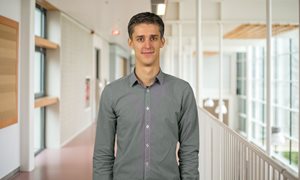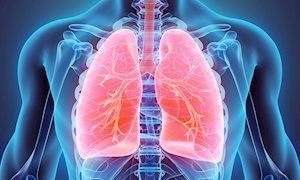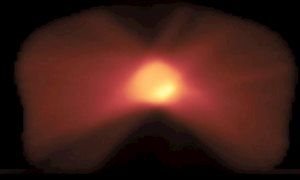 Many pregnant women in developing countries do not receive an ultrasound examination. As a result, pregnancy risks often go unnoticed, which contributes to the high maternal mortality rates in these countries. To help solve this problem, Thomas van den Heuvel of Radboudumc has developed a low-cost ultrasound system that can automatically detect gestational age, breech presentation and twin pregnancies. During his recent defense of his PhD thesis on this research, he concluded: “We hope that this low-cost system will result in more women receiving ultrasound examinations, and if pregnancy risks are detected, that these women will be referred to a hospital.”
Many pregnant women in developing countries do not receive an ultrasound examination. As a result, pregnancy risks often go unnoticed, which contributes to the high maternal mortality rates in these countries. To help solve this problem, Thomas van den Heuvel of Radboudumc has developed a low-cost ultrasound system that can automatically detect gestational age, breech presentation and twin pregnancies. During his recent defense of his PhD thesis on this research, he concluded: “We hope that this low-cost system will result in more women receiving ultrasound examinations, and if pregnancy risks are detected, that these women will be referred to a hospital.”
Low-cost and automated ultrasound system
Biomedical technologist Thomas van den Heuvel developed a low-cost ultrasound system that can automatically interpret ultrasound images. To do so, he used a device costing a few thousand euros, which can be connected to a laptop computer. In comparison, ultrasound devices used in the Netherlands cost between 20,000 and 200,000 euros. This new system can also help women in areas without electricity.
Deep learning
The protocol for making the ultrasound images can be taught to anyone within one day. Van den Heuvel: “In this protocol, the midwife makes three vertical and three horizontal sweeps with the ultrasound transducer across the abdomen of the pregnant woman. Each sweep yields approximately 100 images.” The system then interprets the ultrasound images. To achieve this, Van den Heuvel used ‘deep learning’. He showed the system many examples of ultrasound images with various cross-sections of the fetus. Based on these examples, the system learned to recognize these cross-sections by itself.
Algorithms
The system can determine the gestational age based on automatic measurements of the head circumference of the fetus on the ultrasound images. The system can also recognize twins or a breech presentation. Van den Heuvel compares the automatic analysis of ultrasound images to the image recognition system used by a self-driving car. “For example, the algorithms in the car need to distinguish people from trees. I use similar algorithms for the ultrasound system. The difference is then that it needs to be able to distinguish a single fetus from twins”
Prototype
In March, Van den Heuvel will return to Ethiopia to test the first prototype of his system. “We plan to give the prototype to midwives and see if they are able to use it. We will also determine whether the information provided by the system is used by the midwives to refer pregnant women with risk factors to a hospital” His goal is for women with pregnancy risks to receive appropriate care when they need it. “At present, many pregnant women in developing countries visit a hospital only when it is too late. With this system we hope to detect risk factors in a timely manner and, in combination with the determination of gestational age, we can advise women when they should to go to the hospital,” concludes Van den Heuvel.
Thomas van den Heuvel is member of theme Rare cancers.
Related news items

KWF grant for better selection of individuals and lung nodules in lung cancer screening
1 November 2021 The Dutch Cancer Society has awarded the consortium project ‘Multi-source data approach for Personalized Outcome Prediction in lung cancer screening’ with a grant of 1,425,000 Euro. Colin Jacobs will lead the work package on using artificial intelligence for accurate risk estimation of lung nodules. go to page
Radiation boost lowers risk of prostate cancer recurrence
21 January 2021 An additional external-beam radiation dose delivered directly to the tumor can benefit the prospects of men with non-metastatic prostate cancer, without causing additional side effects. The risk of relapse within five years for these men is smaller than for men who did not receive this boost. go to page
Evaluation of an AI system for detection of COVID-19 on Chest X-Ray images
22 May 2020 In the journal Radiology researchers from Radboudumc, Bernhoven Hospital and Jeroen Bosch Hospital described how an artificial intelligence system (CAD4COVID-XRay) can identify characteristics of COVID-19 on chest x-rays with performance comparable to six independent radiologists. go to page
Is Google's lung cancer AI ready for implementation?
19 December 2019 In Nature Reviews Clinical Oncology, Colin Jacobs and Bram van Ginneken discussed the recent paper by Google AI in Nature Medicine on deep learning models for automatic detection of lung cancer from computed tomography. go to page
Awarded KWF grants for Radboudumc researchers
18 December 2019 KWF is investing 2.7 million euros in five different studies at Radboudumc. The awards are part of the new round of funding by DCS, in which over 34 million euros will be granted to Dutch cancer research. We congratulate our researchers with this funding and wish them success with their great work. go to page
